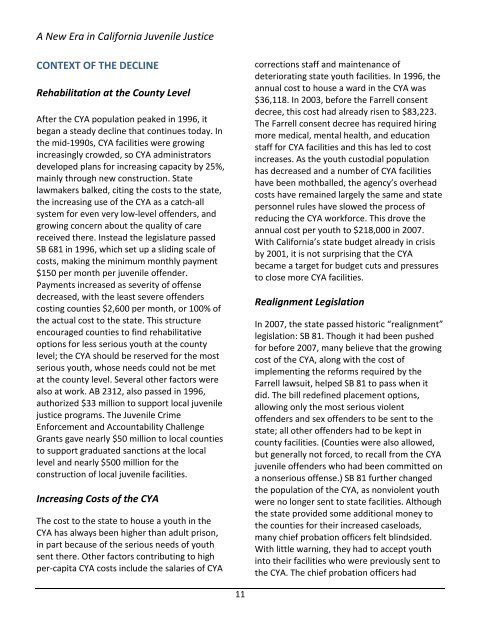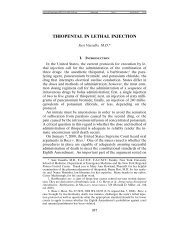October 2010 Barry Krisberg, Ph.D. Linh Vuong Christopher Hartney ...
October 2010 Barry Krisberg, Ph.D. Linh Vuong Christopher Hartney ...
October 2010 Barry Krisberg, Ph.D. Linh Vuong Christopher Hartney ...
Create successful ePaper yourself
Turn your PDF publications into a flip-book with our unique Google optimized e-Paper software.
A New Era in California Juvenile Justice<br />
CONTEXT OF THE DECLINE<br />
Rehabilitation at the County Level<br />
After the CYA population peaked in 1996, it<br />
began a steady decline that continues today. In<br />
the mid-1990s, CYA facilities were growing<br />
increasingly crowded, so CYA administrators<br />
developed plans for increasing capacity by 25%,<br />
mainly through new construction. State<br />
lawmakers balked, citing the costs to the state,<br />
the increasing use of the CYA as a catch-all<br />
system for even very low-level offenders, and<br />
growing concern about the quality of care<br />
received there. Instead the legislature passed<br />
SB 681 in 1996, which set up a sliding scale of<br />
costs, making the minimum monthly payment<br />
$150 per month per juvenile offender.<br />
Payments increased as severity of offense<br />
decreased, with the least severe offenders<br />
costing counties $2,600 per month, or 100% of<br />
the actual cost to the state. This structure<br />
encouraged counties to find rehabilitative<br />
options for less serious youth at the county<br />
level; the CYA should be reserved for the most<br />
serious youth, whose needs could not be met<br />
at the county level. Several other factors were<br />
also at work. AB 2312, also passed in 1996,<br />
authorized $33 million to support local juvenile<br />
justice programs. The Juvenile Crime<br />
Enforcement and Accountability Challenge<br />
Grants gave nearly $50 million to local counties<br />
to support graduated sanctions at the local<br />
level and nearly $500 million for the<br />
construction of local juvenile facilities.<br />
Increasing Costs of the CYA<br />
The cost to the state to house a youth in the<br />
CYA has always been higher than adult prison,<br />
in part because of the serious needs of youth<br />
sent there. Other factors contributing to high<br />
per-capita CYA costs include the salaries of CYA<br />
11<br />
corrections staff and maintenance of<br />
deteriorating state youth facilities. In 1996, the<br />
annual cost to house a ward in the CYA was<br />
$36,118. In 2003, before the Farrell consent<br />
decree, this cost had already risen to $83,223.<br />
The Farrell consent decree has required hiring<br />
more medical, mental health, and education<br />
staff for CYA facilities and this has led to cost<br />
increases. As the youth custodial population<br />
has decreased and a number of CYA facilities<br />
have been mothballed, the agency’s overhead<br />
costs have remained largely the same and state<br />
personnel rules have slowed the process of<br />
reducing the CYA workforce. This drove the<br />
annual cost per youth to $218,000 in 2007.<br />
With California’s state budget already in crisis<br />
by 2001, it is not surprising that the CYA<br />
became a target for budget cuts and pressures<br />
to close more CYA facilities.<br />
Realignment Legislation<br />
In 2007, the state passed historic “realignment”<br />
legislation: SB 81. Though it had been pushed<br />
for before 2007, many believe that the growing<br />
cost of the CYA, along with the cost of<br />
implementing the reforms required by the<br />
Farrell lawsuit, helped SB 81 to pass when it<br />
did. The bill redefined placement options,<br />
allowing only the most serious violent<br />
offenders and sex offenders to be sent to the<br />
state; all other offenders had to be kept in<br />
county facilities. (Counties were also allowed,<br />
but generally not forced, to recall from the CYA<br />
juvenile offenders who had been committed on<br />
a nonserious offense.) SB 81 further changed<br />
the population of the CYA, as nonviolent youth<br />
were no longer sent to state facilities. Although<br />
the state provided some additional money to<br />
the counties for their increased caseloads,<br />
many chief probation officers felt blindsided.<br />
With little warning, they had to accept youth<br />
into their facilities who were previously sent to<br />
the CYA. The chief probation officers had

















